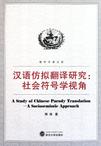汉语仿拟翻译研究
2011-10
武汉大学出版社
熊俊
125
111000
《汉语仿拟翻译研究--社会符号学视角/青年学者文库》由熊俊所著,从社会符号学的历史渊源、意义和功能观、采用社会符号学翻译法的优点入手,结合汉语仿拟的特点及其功能探讨汉语仿拟的社会符号学本质及社会符号学翻译法对汉语仿拟英译的启示。采用了例证法、对照比较法.以社会符号学翻译法所提出的“意义相符,功能相似”的翻译标准为指导。对如何实现汉语仿拟英译过程中的表情功能、美感功能、祈使功能及信息功能对等进行了探讨。同时。本书还对某些处理不甚恰当或未能实现功能对等的译例或者尚无现成翻译的汉语仿拟例句。在分析与批评的基础上提供了尝试性译文。
熊俊,女,1972年11月生,湖北省麻城市人,副教授。英语语言文学硕士。2006年起任孝感学院外国语学院专业教研室主任、科研干事。现为中国翻译协会专家会员。湖北省翻译协会理事,中国比较文学学会翻译研究会会员。已发表论文30余篇,主持参与各级各类教研科研项目多项。参编高校翻译教材1部(《英汉同声传译教程》。武汉大学出版社,2010年9月),参编论文集2本,主编英文翻译教材1部(《英汉互译简明教程》,武汉大学出版社.2011年7月)。多次受邀参加国际国内翻译学术会议。2008年,论文《试析广告英语翻译中“三美”的功能对等》被第十八届世界翻译大会学术委员会评审通过并被大会接受,受邀参加了第十八届世界翻译大会,该论文被收入《第十八届世界翻译大会论文集》(光盘版)(已由外文出版社正式出版)。2010年11月6日至8日应邀参加了由澳门翻译员联合会与澳门大学共同主办、由澳门大学承办的国际译联第六届亚洲翻译家论坛并在论坛宣读论文:“The
Translation of Chinese Parody—A Sociosemiotic
Approach”,该论文被收入《国际译联第六届亚洲翻译家论坛论文精选集》(光盘版)(澳门大学出版)。201
0年荣获首届湖北省翻译协会学术成果评选三等奖。
Chapter One Introduction
1.1 Significance of the Present Study
1.2 Aim of the Present Study
1.3 Methodology and Data Collection
1.4 Outline of the Present Study
Chapter Two Theoretical Background for This Study
2.1 Introduction
2.2 Formation and Development of Sociosemiotic Approach
2.2.1 Semiotics
2.2.2 Sociosemiotics
2.2.3 Sociosemiotic Approach to Translation
2.3 Meanings and Functions from the Perspective of
Sociosemiotic Approach to Translation
2.3.1 Meanings
2.3.2 Functions
2.4 Advantages of Sociosemiotic Approach to Translation
2.5 Summary
Chapter Three Sociosemiotic Approach and Chinese
Parody Translation
3.1 Chinese Parody
3.1.1 Introduction
3.1.2 Definition of Chinese Parody
3.1.3 Classification of Chinese Parody
3.1.4 Characteristics of Chinese Parody Formation
3.1.5 Functions of Chinese Parody
3.1.6 English Counterpart of Chinese Parody
3.1.7 Summary
3.2 Sociosemiotic Nature of Chinese Parody Translation
3.3 Criterion of Translating Chinese Parody
3.3.1 Traditional Criteria ofTranslation
3.3.2 Criterion of Sociosemiotic Approach to Chinese Parody
Translation
3.4 Summary
Chapter Four Application of Sociosemiotic Approach to
Translating Chinese Parody
4.1 Introduction
4.2 Necessity and Possibility of Achieving Equivalence in
Translating Chinese Parody
4.3 Achieving Equivalence in Translating Chinese Parody
4.3.1 Expressive Function Equivalence
4.3.2 Aesthetic Function Equivalence
4.3.3 Vocative Function Equivalence
4.3.4 Informative Function Equivalence
4.4 Means Used in Translating Chinese Parody in
Light of Sociosemiotic Approach
4.4.1 Borrowing
4.4.2 Imitating
4.4.3 Paraphrasing
4.4.4 Adapting
4.5 Summary
Chapter Five Concluding Remarks
5.1 Introduction
5.2 Major Findings
5.3 Limitations and Suggestions
Bibliography
Acknowledgements
